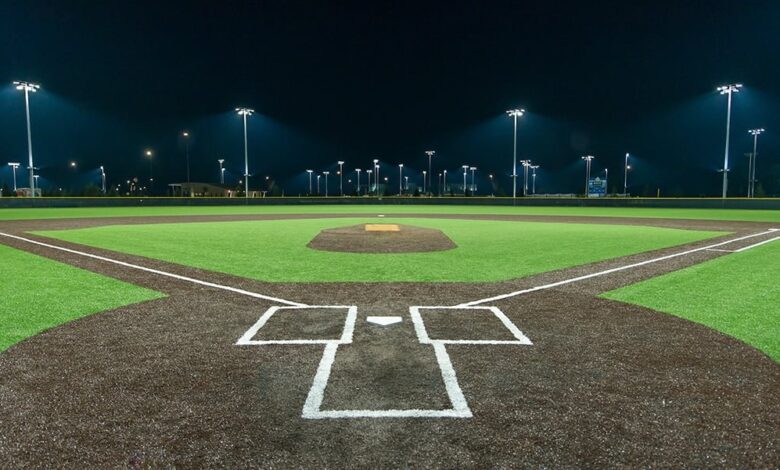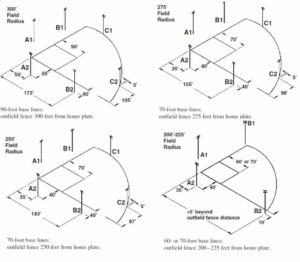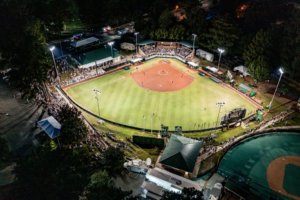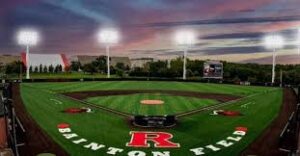Baseball Field Lighting Standards: A Simple Guide for Everyone

Baseball field lighting standards are very important. They help players see the ball clearly and keep everyone safe. In this blog, we will talk about baseball field lighting standards and why they matter.
Having good lighting on a baseball field makes the game better for players and fans. These standards tell us how bright the lights should be and where to put them. Let’s explore these standards and learn how they keep baseball fun and safe for everyone.
What Are Baseball Field Lighting Standards?
Baseball field lighting standards are rules that tell us how to light a baseball field properly. These standards make sure that players can see the ball clearly, even at night. They also help keep the field safe for everyone playing or watching the game.
The standards include details like how bright the lights should be and where to place them around the field. Good lighting helps players track the ball and avoid accidents. These rules are important for all levels of baseball, from little leagues to professional games.
Having the right lighting standards also makes games more enjoyable for fans. When the field is well-lit, spectators can see the action better. These standards help create a fun and safe environment for everyone involved in baseball.
Why Do Baseball Field Lighting Standards Matter?
Baseball field lighting standards are crucial for player safety. When the field is properly lit, players can see the ball clearly and avoid collisions. This reduces the risk of injuries during the game.
These standards also improve the quality of the game. Good lighting allows players to perform their best, as they can see the ball and their teammates easily. This leads to better gameplay and more exciting matches for fans.
Furthermore, following baseball field lighting standards ensures that the game can continue even when it gets dark. This is especially important for evening games. With proper lighting, the game remains fair and enjoyable for everyone.

Minimum Lighting Levels for Professional Baseball
Professional baseball games require high lighting levels to ensure players can see the ball clearly. The minimum lighting levels are set by baseball field lighting standards. These levels help create a safe and competitive environment.
The standards specify how many foot-candles of light are needed. A foot-candle is a unit of light measurement. For professional fields, the infield usually needs about 70-100 foot-candles, while the outfield needs around 50-70 foot-candles.
These lighting levels help players perform at their best. Clear visibility is crucial for hitting, pitching, and fielding. Following the minimum lighting standards ensures the game is played fairly and safely.
Lighting Standards for College Baseball Fields
College baseball fields have specific lighting standards to ensure safe and fair play. These standards are a bit different from professional fields but still important. They help maintain a good level of visibility for players.
The standards for college fields usually require around 50-70 foot-candles for the infield and 30-50 foot-candles for the outfield. This lighting helps players see the ball and each other clearly, which is essential for safety and performance.
College games often happen in the evening, so good lighting is crucial. Proper lighting standards make sure that games can continue without interruption, providing a great experience for players and fans alike.
High School Baseball Field Lighting Standards
High school baseball field lighting standards are important for young athletes. These standards ensure that the field is well-lit, making it safer for players. Good lighting helps prevent accidents and injuries during the game.
The standards for high school fields usually call for about 30-50 foot-candles for the infield and 20-30 foot-candles for the outfield. These levels provide enough light for players to see the ball and their surroundings clearly.
Having proper lighting is also important for evening games. High school games often take place after school, so following lighting standards ensures that games can be played safely even when it gets dark.
Youth Baseball Field Lighting Standards Explained
Youth baseball fields have specific lighting standards to keep young players safe. These standards help ensure that the field is bright enough for children to see the ball and avoid accidents. Safety is a top priority in youth sports.
The standards for youth fields usually require around 20-30 foot-candles for the infield and 10-20 foot-candles for the outfield. These levels provide sufficient light for young players, helping them enjoy the game without worrying about visibility.
Proper lighting also makes the game more enjoyable for spectators. Parents and fans can see the action clearly, making the experience better for everyone. Following these standards is important for a fun and safe game.
Infield vs. Outfield Lighting: What You Need to Know
Infield and outfield lighting standards are different. The infield needs more light because it is where most of the action happens. Players need to see the ball clearly when it is hit or thrown quickly.
In the infield, lighting standards usually require around 50-70 foot-candles. This ensures that players can see the ball well and react quickly. Good infield lighting helps prevent errors and keeps the game fair.
The outfield lighting standards are a bit lower, usually around 30-50 foot-candles. This is because the ball is usually moving slower in the outfield. However, good lighting is still important to help outfielders catch fly balls and make plays.
How Bright Should Baseball Field Lights Be?
Baseball field lighting standards tell us how bright the lights should be. The brightness is measured in foot-candles, a unit of light. Proper brightness ensures that players can see the ball and each other clearly.
For professional fields, the infield should have about 70-100 foot-candles of light. The outfield should have around 50-70 foot-candles. These levels provide enough light for players to perform well and stay safe.
Different levels of baseball have different lighting standards. College, high school, and youth fields have lower brightness requirements. However, they still need to be bright enough to ensure good visibility and safety for players.
The Importance of Uniform Lighting on Baseball Fields
Uniform lighting is a key part of baseball field lighting standards. This means that the light should be spread evenly across the field. Even lighting helps players see the ball and each other from any part of the field.
Uneven lighting can create dark spots and glare, which can be dangerous. Players might not see the ball clearly, leading to mistakes and accidents. Uniform lighting helps prevent these issues and keeps the game fair.
To achieve uniform lighting, lights need to be placed and angled correctly. Regular maintenance is also important to keep the lights working well. Following these standards ensures a safe and enjoyable game for everyone.

Maximum Lighting Differences: Infield vs. Outfield
The infield and outfield have different lighting needs. Baseball field lighting standards help determine the maximum differences in brightness between these areas. This balance is important for player visibility and safety.
The infield usually needs brighter lighting, around 70-100 foot-candles. The outfield needs less, about 50-70 foot-candles. These differences help players see the ball clearly whether they are in the infield or outfield.
Balancing the lighting between the infield and outfield is crucial. Too much difference can create visibility issues. Following the maximum lighting differences ensures a fair and safe game for all players.
Lighting the Home Plate Area: Standards and Tips
The home plate area requires special attention when it comes to lighting. Baseball field lighting standards ensure this area is well-lit. Good lighting helps batters see the ball clearly as it comes towards them.
The home plate area should have about 100 foot-candles of light. This bright lighting helps batters track the ball from the pitcher’s hand to the plate. Proper lighting also helps catchers and umpires see better.
Placing lights at the right angles is important for the home plate area. Lights should minimize glare and shadows, providing a clear view for everyone. Following these standards and tips keeps the game safe and fair.
Best Placement for Baseball Field Lights
Placing lights correctly is crucial for meeting baseball field lighting standards. Proper placement ensures that the entire field is well-lit, providing good visibility for players. Lights should be positioned to minimize shadows and glare.
Light poles are usually placed around the perimeter of the field. This helps distribute the light evenly across both the infield and outfield. Proper placement also ensures that players are not blinded by direct light.
Infield lights should be placed closer together to provide bright, uniform lighting. Outfield lights can be spaced a bit further apart but still need to provide good coverage. Following these placement guidelines helps create a safe and enjoyable game environment.
How Far Should Light Poles Be from the Field?
The distance of light poles from the field is important. Baseball field lighting standards provide guidelines for this. Proper distance ensures that the field is well-lit without causing glare or shadows.
Light poles are usually placed around 60-80 feet from the infield and outfield boundaries. This distance helps distribute the light evenly across the field. It also keeps the lights high enough to cover a wide area.
Correct pole placement helps players see the ball clearly and avoids distractions. It also helps protect the poles from being hit by stray balls. Following these distance guidelines ensures a safe and well-lit field.
Height Guidelines for Baseball Field Light Poles
The height of light poles is crucial for effective field lighting. Baseball field lighting standards specify how tall these poles should be. Proper height ensures that the lights cover the field evenly and minimize shadows.
For professional fields, light poles are usually around 60-100 feet tall. This height allows the lights to spread out over a large area, providing uniform coverage. High poles also reduce glare and improve visibility for players.
Different levels of baseball have different height requirements. College and high school fields may use slightly shorter poles, around 50-80 feet tall. Following these height guidelines helps create a safe and well-lit playing environment.
Angle and Direction of Baseball Field Lights
The angle and direction of lights are important for good field lighting. Baseball field lighting standards help determine the best angles. Properly angled lights provide even coverage and reduce glare.
Lights should be angled to shine directly onto the field. This helps avoid shadows and dark spots. Infield lights are usually angled more steeply to provide bright, focused lighting. Outfield lights are angled to cover a wider area.
Adjusting the direction of lights is also important. Lights should not shine directly into players’ eyes. Proper angle and direction ensure that the field is well-lit and safe for everyone.
Reducing Glare on Baseball Fields
Glare can be a big problem on baseball fields. Baseball field lighting standards include tips for reducing glare. Proper lighting helps players see the ball clearly and avoids distractions.
Using low-glare lights is one way to reduce glare. These lights are designed to spread light evenly without causing bright spots. Shielding lights can also help direct the light where it’s needed and reduce glare.
Proper placement and angling of lights are also important. Lights should not shine directly into players’ eyes or create reflections. Following these tips helps keep the field well-lit and safe.
Using Low-Glare Lights for Better Visibility
Low-glare lights are a great choice for baseball fields. Baseball field lighting standards often recommend these lights. They help provide even lighting and improve visibility for players.
Low-glare lights are designed to reduce bright spots and reflections. This helps players see the ball and each other clearly. Using these lights can also make the game more enjoyable for spectators.
Properly installing low-glare lights is important. They should be placed and angled correctly to provide the best coverage. Following these standards ensures a safe and well-lit field for everyone.
The Role of Shielding in Baseball Field Lighting
Shielding is an important part of baseball field lighting standards. It helps direct the light where it’s needed and reduces glare. Proper shielding ensures that the field is well-lit and safe.
Shields are placed on lights to control the direction of the light. This helps focus the light on the field and avoid bright spots. Shielding also helps reduce light pollution and keep the surrounding area dark.
Using shields can improve the quality of lighting on the field. They help create even coverage and reduce distractions for players. Following these shielding standards keeps the game fair and enjoyable.
Regular Maintenance of Baseball Field Lights
Regular maintenance is key to keeping baseball field lights in good condition. Baseball field lighting standards include guidelines for maintenance. Proper upkeep ensures that the lights work well and provide good visibility.
Lights should be checked regularly for any issues. This includes checking for burned-out bulbs, damaged fixtures, and alignment problems. Fixing these issues promptly helps maintain good lighting on the field.
Cleaning the lights is also important. Dust and dirt can reduce the brightness of the lights. Regular cleaning helps keep the lights bright and effective. Following these maintenance guidelines ensures a safe and well-lit field.
How Often Should Baseball Field Lights Be Replaced?
Replacing baseball field lights is necessary to maintain good lighting. Baseball field lighting standards provide guidelines for how often to replace lights. Regular replacement ensures that the lights are bright and effective.
Lights should be replaced every few years, depending on their usage. High-quality lights can last longer but should still be checked regularly. Replacing old or dim lights helps keep the field well-lit.
Using energy-efficient lights can also reduce the need for frequent replacements. These lights last longer and provide good coverage. Following these replacement guidelines keeps the field safe and enjoyable for players and fans.
Environmental Impact of Baseball Field Lighting
Baseball field lighting can have an impact on the environment. Baseball field lighting standards include tips for reducing this impact. Using energy-efficient lights and proper placement helps minimize environmental effects.
Energy-efficient lights use less electricity and last longer. This reduces the amount of energy needed to light the field. Using these lights can also save money on energy bills.
Proper placement and shielding of lights help reduce light pollution. This keeps the surrounding area dark and minimizes the impact on wildlife. Following these standards helps create a more sustainable and environmentally friendly field.
Energy Efficiency in Baseball Field Lighting
Energy efficiency is important for baseball field lighting. Baseball field lighting standards often recommend using energy-efficient lights. These lights provide good coverage while using less electricity.
LED lights are a popular choice for energy efficiency. They use less power and last longer than traditional lights. Using LED lights can reduce energy costs and improve the quality of lighting on the field.
Proper maintenance and placement also help improve energy efficiency. Well-maintained lights provide better coverage and use less energy. Following these standards helps create a more sustainable and cost-effective field.
Safety Considerations for Baseball Field Lights
Safety is a top priority for baseball field lighting standards. Proper lighting helps prevent accidents and injuries on the field. Good visibility is crucial for player safety during the game.
Lights should be placed and angled to avoid creating shadows or bright spots. This helps players see the ball and each other clearly. Regular maintenance ensures that the lights work well and provide consistent coverage.
Using low-glare and shielded lights can also improve safety. These lights reduce distractions and help players focus on the game. Following these safety standards keeps the field safe and enjoyable for everyone.
Common Issues with Baseball Field Lighting and Solutions
Baseball field lighting can have some common issues. Baseball field lighting standards provide solutions for these problems. Proper maintenance and installation help prevent and fix these issues.
One common issue is burned-out bulbs. Regularly checking and replacing bulbs helps keep the lights bright. Another issue is glare, which can be reduced by using low-glare lights and proper shielding.
Alignment problems can also affect lighting quality. Regularly adjusting the lights ensures even coverage. Following these solutions helps maintain good lighting and create a safe playing environment.

Designing the Perfect Baseball Field Lighting System
Designing a good lighting system is important for meeting baseball field lighting standards. A well-designed system provides even coverage and good visibility for players. Proper design helps create a safe and enjoyable field.
The design should include the right number of lights and their proper placement. Lights should be positioned to cover both the infield and outfield evenly. Using low-glare and energy-efficient lights can improve the quality of lighting.
Regular maintenance and adjustments are also part of a good design. Keeping the lights in good condition ensures consistent coverage. Following these design standards helps create the perfect lighting system for any baseball field.
Conclusion
Baseball field lighting standards are super important for making sure games are safe and fun. These rules tell us how bright the lights should be and where to put them. Good lighting helps players see the ball and each other clearly, which makes the game better and safer for everyone.
Following these standards also makes watching games more enjoyable for fans. With the right lighting, everyone can see the action perfectly, even at night. So, whether you’re playing or cheering from the stands, proper baseball field lighting keeps the game exciting and safe!



